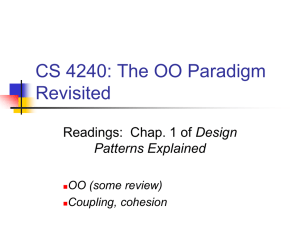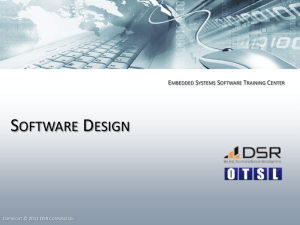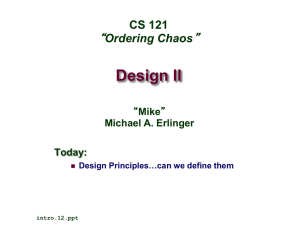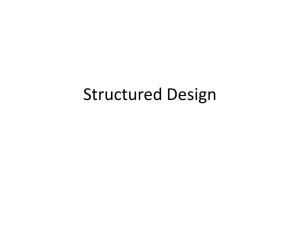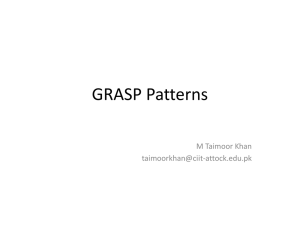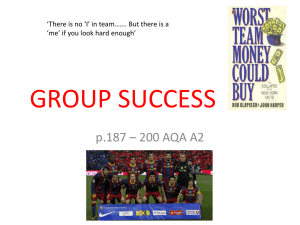Cohesion and Coupling
advertisement
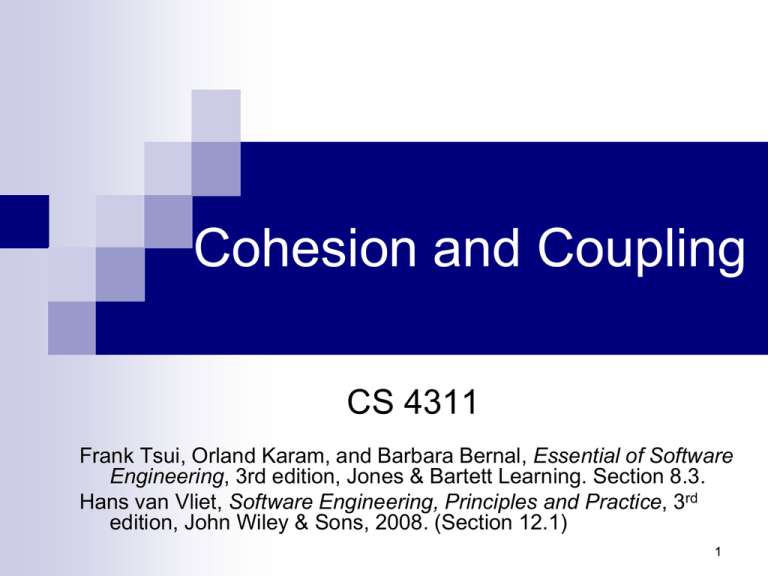
Cohesion and Coupling
CS 4311
Frank Tsui, Orland Karam, and Barbara Bernal, Essential of Software
Engineering, 3rd edition, Jones & Bartett Learning. Section 8.3.
Hans van Vliet, Software Engineering, Principles and Practice, 3rd
edition, John Wiley & Sons, 2008. (Section 12.1)
1
Outline
Cohesion
Coupling
2
Characteristics of Good Design
Component independence
High cohesion
Low coupling
Exception identification and handling
Fault prevention and fault tolerance
Design for change
M1
M2
M3
3
Cohesion
Definition
The degree to which all elements of a component are
directed towards a single task.
The degree to which all elements directed towards a
task are contained in a single component.
The degree to which all responsibilities of a single
class are related.
Internal glue with which component is constructed
All elements of component are directed toward and
essential for performing the same task.
4
Type of Cohesion
High Cohesion
Functional
Sequential
Communicational
Procedural
Temporal
Logical
Coincidental
Low
5
Coincidental Cohesion
Functional
Sequential
Communicational
Procedural
Temporal
Logical
Coincidental
Def: Parts of the component are unrelated (unrelated
functions, processes, or data)
Parts of the component are only related by their location
in source code.
Elements needed to achieve some functionality are
scattered throughout the system.
Accidental
Worst form
6
Example
1.
2.
3.
4.
Print next line
Reverse string of characters in second
argument
Add 7 to 5th argument
Convert 4th argument to float
7
Logical Cohesion
Functional
Sequential
Communicational
Procedural
Temporal
Logical
Coincidental
Def: Elements of component are related logically
and not functionally.
Several logically related elements are in the
same component and one of the elements is
selected by the client component.
8
Example
A component reads inputs from tape, disk, and
network.
All the code for these functions are in the same
component.
Operations are related, but the functions are
significantly different.
Improvement?
9
Temporal Cohesion
Functional
Sequential
Communicational
Procedural
Temporal
Logical
Coincidental
Def: Elements are related by timing involved
Elements are grouped by when they are
processed.
Example: An exception handler that
Closes
all open files
Creates an error log
Notifies user
Lots of different activities occur, all at same time
10
Example
A system initialization routine: this routine contains all
of the code for initializing all of the parts of the
system. Lots of different activities occur, all at init
time.
Improvement?
11
Procedural Cohesion
Functional
Sequential
Communicational
Procedural
Temporal
Logical
Coincidental
Def: Elements of a component are related only to
ensure a particular order of execution.
Actions are still weakly connected and unlikely to be
reusable.
Example:
...
Write output record
Read new input record
Pad input with spaces
Return new record
...
12
Communicational Cohesion
Functional
Sequential
Communicational
Procedural
Temporal
Logical
Coincidental
Def: Functions performed on the same data or to
produce the same data.
Examples:
Update
Update a record on a database
Print the record
Fetch
record in data base and send it to the printer
unrelated data at the same time.
To minimize disk access
13
Sequential Cohesion
Functional
Sequential
Communicational
Procedural
Temporal
Logical
Coincidental
Def: The output of one part is the input to
another.
Data flows between parts (different from
procedural cohesion)
Occurs naturally in functional programming
languages
Good situation
14
Functional Cohesion
Functional
Sequential
Communicational
Procedural
Temporal
Logical
Coincidental
Def: Every essential element to a single computation is
contained in the component.
Every element in the component is essential to the
computation.
Ideal situation
What is a functionally cohesive component?
One that not only performs the task for which it was designed but
it performs only that function and nothing else.
15
Examples of Cohesion
Function A
Function A
Time t0
Function A’
Time t0 + X
Function A’’
Time t0 + 2X
Coincidental
Logical
Temporal
Parts unrelated
Similar functions
Related by time
Function Function
B
C
Function Function
D
E
logic
Function A
Function B
Function C
Procedural
Related by order of functions
16
Examples of Cohesion (Cont.)
Function A
Function A
Function B
Function B
Function C
Function C
Communicational
Sequential
Access same data
Output of one is input to another
Function A part 1
Function A part 2
Function A part 3
Functional
Sequential with complete, related functions
17
Exercise: Cohesion for Each Module?
Compute average daily temperatures at various sites
Initialize sums and open files
Create new temperature record
Store temperature record
Close files and print average temperatures
Read in site, time, and temperature
Store record for specific site
Functional
Sequential
Communicational
Edit site, time, or temperature field
Procedural
Temporal
Logical
Coincidental
18
Outline
Cohesion
Coupling
19
Coupling
The degree of dependence such as the amount
of interactions among components
No dependencies
Loosely coupled
some dependencies
Highly coupled
many dependencies
20
Coupling
The degree of dependence such as the amount
of interactions among components
How can you tell if two components are
coupled?
(In pairs, 2 minutes)
21
Indications of Coupling
?
22
Type of Coupling
High Coupling
Loose
Low
Content
Common
Avoid
External
Control
Stamp
Data
Uncoupled
Try to achieve
23
Content Coupling
Content
Common
External
Control
Stamp
Data
Uncoupled
Def: One component modifies another.
Example:
Component
directly modifies another’s data
Component modifies another’s code, e.g., jumps
(goto) into the middle of a routine
Question
Language features allowing this?
24
Example
Part of a program handles lookup for customer.
When customer not found, component adds customer by
directly modifying the contents of the data structure
containing customer data.
Improvement?
25
Common Coupling
Content
Common
External
Control
Stamp
Data
Uncoupled
Def: More than one component share data
such as global data structures
Usually a poor design choice because
Lack
of clear responsibility for the data
Reduces readability
Difficult to determine all the components that affect
a data element (reduces maintainability)
Difficult to reuse components
Reduces ability to control data accesses
26
Example
Process control component maintains current data
about state of operation. Gets data from multiple
sources. Supplies data to multiple sinks. Each source
process writes directly to global data store. Each sink
process reads directly from global data store.
Improvement?
27
External Coupling
Content
Common
External
Control
Stamp
Data
Uncoupled
Def: Two components share something
externally imposed, e.g.,
External
file
Device interface
Protocol
Data format
Improvement?
28
Control Coupling
Def: Component passes control parameters to coupled
components.
May be either good or bad, depending on situation.
Content
Common
External
Control
Stamp
Data
Uncoupled
Bad if parameters indicate completely different behavior
Good if parameters allow factoring and reuse of functionality
Good example: sort that takes a comparison function as
an argument.
The sort function is clearly defined: return a list in sorted order,
where sorted is determined by a parameter.
29
Stamp Coupling
Content
Common
External
Control
Stamp
Data
Uncoupled
Def: Component passes a data structure to another
component that does not have access to the entire
structure.
Requires second component to know how to manipulate
the data structure (e.g., needs to know about
implementation).
The second has access to more information that it needs.
May be necessary due to efficiency factors: this is a
choice made by insightful designer, not lazy programmer.
30
Example
Customer Billing System
The print routine of the customer billing accepts
customer data structure as an argument, parses it,
and prints the name, address, and billing information.
Improvement?
31
Improvement --- OO Solution
Use an interface to limit access from clients
Customer
get name
get address
get billing info
get other info
…
?
void print (Customer c) { … }
32
Data Coupling
Content
Common
External
Control
Stamp
Data
Uncoupled
Def: Component passes data (not data
structures) to another component.
Every argument is simple argument or data
structure in which all elements are used
Good, if it can be achieved.
Example: Customer billing system
The
print routine takes the customer name, address,
and billing information as arguments.
CS 4311
33
Uncoupled
Content
Content
Common
Common
External
Control
Control
Stamp
Stamp
Data
Data
Uncoupled
Uncoupled
Completely uncoupled components are not
systems.
Systems are made of interacting components.
34
Exercise: Define Coupling between Pairs of Modules
Content
Common
External
Control
Stamp
Data
Uncoupled
P
List of Parts
Status Flag
Q
R
Order information
Message
Code
U
Sorted List of parts
Message
Parts order
T
Object containing
List of messages and
List of formatting instructions
S
35
Coupling between Pairs of Modules
Q
R
S
T
U
P
Q
R
S
T
36
Consequences of Coupling
Why does coupling matter? What are the costs
and benefits of coupling?
(pairs, 3 minutes)
37
Consequences of Coupling
High coupling
Components
are difficult to understand in isolation
Changes in component ripple to others
Components are difficult to reuse
Need to include all coupled components
Difficult to understand
Low coupling
May
incur performance cost
Generally faster to build systems with low coupling
38
In Class
Groups of 2 or 3:
P1: What is the effect of cohesion on
maintenance?
P2: What is the effect of coupling on
maintenance?
39

